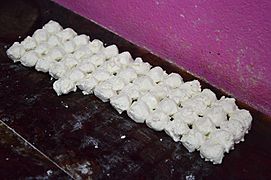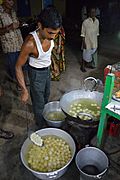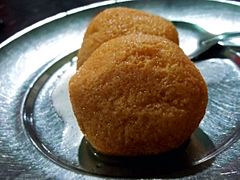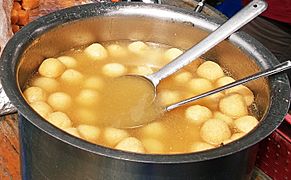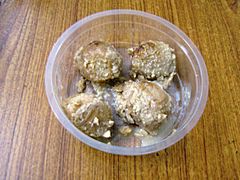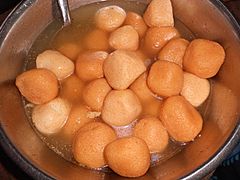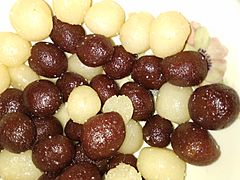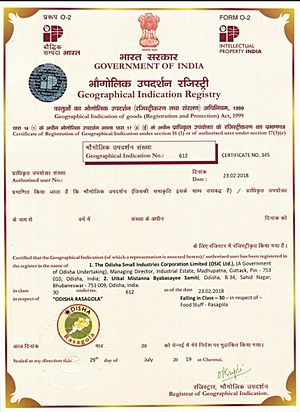Rasgulla facts for kids

Pahala rasagolas from Odisha (left) and Bengali roshogollas from West Bengal (right)
|
|
| Alternative names | Rasagola, rosgola, roshogolla, rossogolla, rasbhari or rasbari (Nepali) |
|---|---|
| Course | Dessert |
| Place of origin | Indian subcontinent |
| Region or state | Odisha and West Bengal |
| Associated national cuisine | India, Bangladesh, Pakistan, Nepal |
| Serving temperature | Hot, cold, or room temperature |
| Main ingredients | Chhena, sugar |
| Variations | Bengali rosogolla, Odia rasagola |
| Similar dishes | Ras malai, khiramohana, Khondoler misti |
Rasgulla is a super popular sweet treat from the Indian subcontinent. You might also hear it called rasagola, rosogola, or rosogolla. It's especially loved in the Bengal region.
This yummy dessert is made from soft, ball-shaped dumplings. These balls are created from chhena (which is a type of Indian cottage cheese) and a little bit of semolina dough. They are then cooked in a light, sweet sugar syrup until they soak up all that delicious sweetness.
People generally agree that rasgulla started in the eastern part of the Indian subcontinent. However, exactly where it began is a bit of a friendly debate! Some say it was in West Bengal, others in Bangladesh, and many believe it started in Odisha. In Odisha, it's a special offering at the Puri Jagannath Temple.
Because of this debate, both West Bengal and Odisha have applied for a special tag called a geographical indication (GI). This tag helps protect the unique identity of products from specific places. West Bengal got its GI tag for "Banglar rosogolla" (Bengali rasgulla) in 2017. Odisha then got its GI tag for "Odisha Rasagola" in 2019. This means both regions have their own special versions of this sweet!
Contents
What's in a Name?
The name "Rasgulla" comes from two words: ras meaning "juice" and gulla meaning "ball." So, it's a "juicy ball"!
In different languages, it has slightly different names:
- In Bengali, it's called pronounced [rɔʃoɡolːa].
- In Odia, it's pronounced [ɾɔsɔɡola].
- In Sanskrit, it's pronounced [rɐsɐɡoːlɐkɐm].
Other common names include Rasagulla, Rossogolla, Roshogolla, Rasagola, and Rasbhari or Rasbari in Nepal.
Rasgulla's Story
Odisha's Claim: An Ancient Tradition
Many historians from Odisha believe that rasgulla started in Puri. They say it was first known as khira mohana and later became the Pahala rasgulla.
It has been a traditional offering, called bhog, to the goddess Lakshmi at the Jagannath Temple, Puri. There's a local story that says Goddess Lakshmi gets upset when her husband, Lord Jagannath, goes on a 9-day trip (the ratha yatra) without her permission. To make her happy, Lord Jagannath offers her rasgullas! This special event is called Bachanika and happens during the "Niladri Bije" festival. This festival celebrates the gods returning to the temple after the big chariot festival.
Some scholars say this tradition has been around since the 12th century. Old temple writings, over 300 years old, also mention this rasgulla offering.
There's also a folk tale about Pahala, a village near Bhubaneshwar. This village had many cows and lots of extra milk. When the milk spoiled, villagers would throw it away. A priest from the Jagannath Temple saw this waste. He taught them how to make cheese (chhena) and the recipe for rasagulla. Because of this, Pahala became famous for its chhena-based sweets.
An Odia researcher named Asit Mohanty says that the sweet "Rasagola" is mentioned in a 15th-century book called Jagamohana Ramayana. This book also talks about other cheese sweets like Chhenapuri and Rasabali. This suggests that making cheese was known in Odisha even before the Portuguese arrived.
Some Bengali historians disagree with these claims. They say that cheese (chhena) wasn't really used in India before the 17th century. Before that, milk sweets were mostly made from khoa. They believe the Portuguese brought the idea of cheese-based sweets to India. So, they think it's unlikely a cheese sweet was offered at the Jagannath Temple in the 12th century. Also, some argue that offering something made from "spoiled" milk (chhena) to a god would have been wrong. However, others point out that food rules can be different in various regions.
Bengal's Claim: A Modern Invention
West Bengal's Story
Many believe the spongy white rasgulla we know today was created in West Bengal in 1868. A sweet maker from Kolkata named Nobin Chandra Das is often given credit. He started making rasgulla by boiling a mix of chhena and semolina in sugar syrup. His family says his recipe was totally new. Others think he improved an older Odisha recipe to make a version that lasted longer.
Another idea is that someone else in Bengal made rasgulla first, and Nobin Chandra Das just made it famous. Some historians say a man named Braja Moira sold rasgulla in Kolkata in 1866, two years before Das. Another story says it was invented by Haradhan Moira in the 19th century. Many similar sweets existed under different names, like gopalgolla and rasugolla. This suggests that rasgulla might be older than Nobin Chandra Das's famous version.
A businessman named Bhagwandas Bagla helped make Bengali rasgulla popular. He ordered huge amounts from Nobin Chandra Das's shop.
Bangladesh's Story
Some believe the Portuguese settlers brought the idea of sweet cheese and Sandesh-like sweets to Bengal in the 16th century. Bengali homemakers then made their own versions. Some say that Nobin Chandra Das's family was originally from Barisal in Bangladesh. This suggests that the main idea for rasgulla might have started in Bangladesh before becoming popular in Kolkata.
How Popular It Is Today
In 1930, Nobin Chandra Das's son, Krishna Chandra Das, started using vacuum packing for rasgullas. This meant they could be put in cans and sent far away! This made the dessert popular not just in Kolkata, but all over India and even outside the country.
Today, you can find canned rasgullas in India, Pakistan, Bangladesh, and in many South Asian grocery stores around the world. In Nepal, it's known as Rasbari.
Even the ISRO (India's space agency) is working on making dehydrated rasgullas for Indian astronauts!
In 2015, Odisha tried to get a GI tag for its Pahala rasagulla. On July 30, people in Odisha celebrated "Rasagola Dibasa" ("Rasgulla Day") to show that they believe the dish started there. West Bengal then decided to fight this legally to protect its own claim. Both states eventually got their own GI tags for their specific versions of rasgulla.
Rasagola Dibasa (Rasgulla Day)
On July 30, 2015, a social media campaign started using the hashtag #RasagolaDibasa. This day became a big celebration to mark Odisha as the origin of rasgulla. Newspapers and radio stations in Odisha held events. A famous sand artist, Sudarshan Patnaik, even made a sand sculpture on Puri Beach showing Lord Jagannath offering rasgulla to Lakshmi.
Now, "Rasagola Dibasa" is celebrated every year on the same day as the "Niladri Bije" festival.
Rosogolla Utsob (Rosogolla Festival)
To honor Nobin Chandra Das, who is believed to have invented the modern Bengali rosogolla, West Bengal started celebrating "Rosogolla Utsob" every year on December 28.
In 2017, at the 'Rosogolla festival', Bengali sweet makers created the world's largest Rasgulla, weighing an amazing 9 kilograms! To celebrate 150 years since the invention of Rosogolla, West Bengal also held a big 3-day festival from December 28 to December 30, 2018.
How to Make Rasgulla
To make rasgulla, first, the soft cheese (chhena) mixture is rolled into small balls. These balls are then gently cooked in a sweet sugar syrup. You can also make them using a pressure cooker or an oven. When serving, some people like to add a tiny drop of edible rose water to make it taste even better!
Different Kinds of Rasgulla
The Pahal Rasagola from the Pahala area (between Bhubaneshwar and Cuttack) is very popular in India.
-
Bikali Kar Rasagola from Salepur, Cuttack, Odisha
-
Kamalabhog, an orange-flavoured Bengali rasgulla
Related Sweets
Rasgulla is one of three traditional Odia chhena desserts, along with chhena gaja and chhena poda. Even though rasgulla is also linked to Bengali cuisine, the Odisha Milk Federation has tried to make chhena poda the main Odia dessert.
How Nutritious is it?
A 100-gram serving of rasgulla has about 186 calories. Most of these calories (around 153) come from carbohydrates. It also contains about 1.85 grams of fat and 4 grams of protein.
Geographical Indication (GI) Tag
In 2015, West Bengal applied for a Geographical Indication (GI) status for "Banglar Rasogolla" (Bengali Rasgulla). They explained that their version was different from Odisha's in color, texture, taste, juice content, and how it was made. On November 14, 2017, West Bengal was granted the GI status for Banglar Rasogolla.
The GI office later clarified that West Bengal got the tag only for its Bengali version of Rasgulla, not for being the original place where the sweet was invented. They also said that Odisha could get its own GI tag for "Odisha Rasagola" if it provided the necessary proof.
In 2018, Odisha applied for its GI status. On July 29, 2019, the GI Registry of India officially granted Odisha the GI status for Odisha Rasagola.
See also
 In Spanish: Rasgulla para niños
In Spanish: Rasgulla para niños


